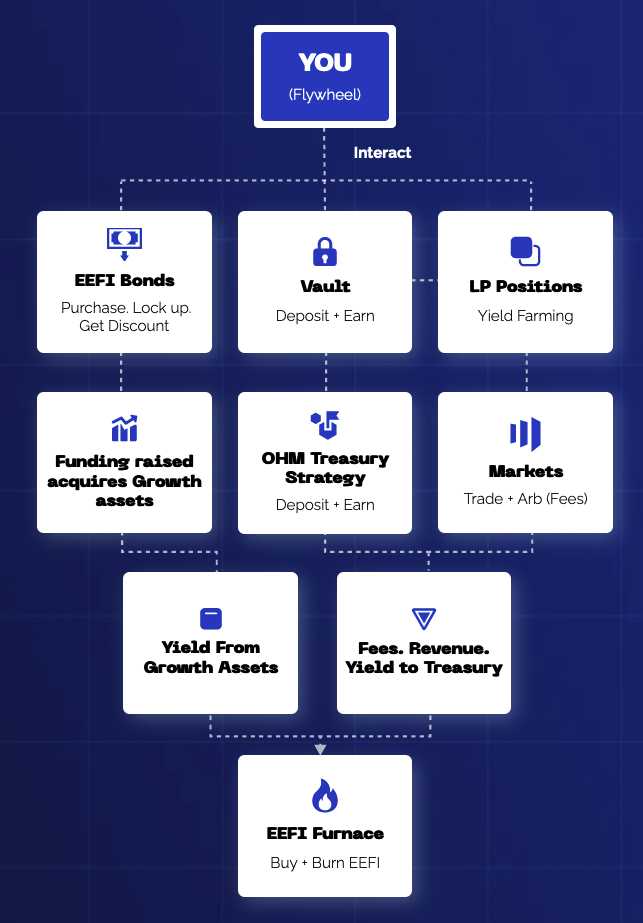Elastic Protocol 101
Learn how the Elastic Protocol operates and about strategies scheduled for launch in the future.
How Does the Elastic Protocol Work?
The Elastic Protocol is an inter-connected series of strategies and tactics (collectively known as the Flywheel) all focused on building a sustainable protocol Treasury that can be deployed to support (and buy and burn) the yield token EEFI.
Elastic Protocol Flywheel

Elastic Protocol Flywheel Components
The Elastic Protocol Flywheel consists of:
The Elastic Vault, which creates opportunities for holders of OHM, AMPL (and other elastic assets in the future, via 'sub-vaults'). The protocol achieves this by:
Leveraging the native rebasing capabilities of the Ampleforth token (AMPL). Due to the rebase, the AMPL token has three states:
Negative rebase: AMPL token supply declines
Steady State (Neutral rebase): AMPL token supply remains constant
Positive rebase: AMPL token supply increases.
The protocol's core Elastic Vault automatically monitors the state of the Ampleforth protocol (positive, negative or neutral rebase), and uses this information to mint or burn the protocol's yield token, EEFI. This automated activity enables those staking AMPL in the Elastic Vault to maximize the utility of the asset across rebase cycles.
Earn OHM and EEFI Rewards: Those depositing AMPL into the protocol's core Elastic Vault will earn rewards in the form of EEFI and OHM. EEFI is minted to AMPL depositors during neutral and negative rebases. During positive AMPL rebases, a percentage of AMPL will be sold for OHM, which will be used to buy and burn EEFI. In addition, a portion of purchased OHM will be delivered to AMPL Elastic Vault stakers (and OHM/EEFI LP token stakers, as outlined below).
Provide OHM/EEFI Liquidity: OHM will play a central role in the functionality of the Elastic Protocol. The protocol's core Elastic Vault will use OHM/EEFI liquidity on Uniswap to buy and burn EEFI during positive AMPL rebases. OHM holders will be able to provide OHM/EEFI liquidity and deposit their LP tokens into the vault. LP token stakers will receive EEFI rewards during neutral and negative AMPL rebases, and OHM rewards during positive AMPL rebases.
EEFI Bonds, which provide community members with the opportunity to purchase EEFI at a discount from market prices directly from the Elastic Protocol. Bond proceeds will be used for a variety of purposes, including thickening protocol-owned EEFI/ASSET liquidity, and acquiring growth assets, such as liquid staking derivatives that generate yield. Fee income from growth assets will be used to buy and burn EEFI.
LP Positions include core pools (EEFI/WETH, EEFI/OHM, etc.) and liquiidty provided in other assets. LP positions generate fees that are used to buy and burn EEFI.
Olympus DAO Treasury Strategies to Earn "Real Yield": The Elastic Protocol, via our partnership with Olympus DAO, will enable the protocol and community members to passively participate in the Olympus Economy via OHM bonds and other products/services. Go here for more information.
Future Flywheel Activities
In the future Elastic Protocol Flywheel strategies will be expanded to include other elastic assets and reward-generation strategies recommended and developed by the Elastic Finance DAO and third-parties.